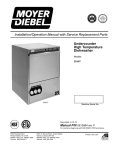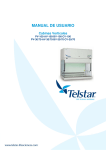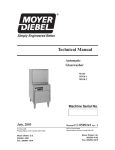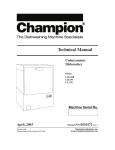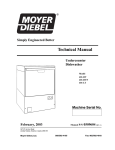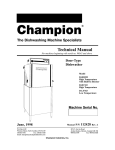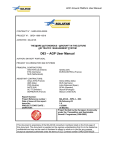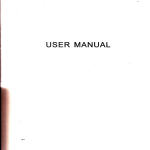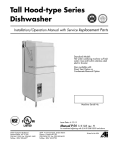Download CMA Dishmachines CMA-66H Troubleshooting guide
Transcript
CMA Dishmachines 12700 Knott Street Garden Grove, CA 92841 Toll Free: Fax: 1- (800) 854-6417 1- (714) 895-2141 Installation/Operation Manual Undercounter High Temperature Dishwasher Models: UC65e UC65e Machine Serial No. Issue Date: 4.17.09 Manual P/N 0512865 rev. 0 For machines beginning with S/N W090217876 and above CMA Dishmachines 12700 Knott Street Garden Grove, CA 92841 Toll Free: 1 (800) 854-6417 Fax: 1 (714) 895-2141 Printed in the USA For future reference, record your dishwasher information in the box below. Model Number__________________________ Serial Number_______________________ Voltage________________Hertz_____________ Phase__________________ Service Agent __________________________________ Tel:______________________ Parts Distributor _________________________________ Tel:______________________ National Service Department CMA Dishmachines 12700 Knott Avenue Garden Grove, CA 92841 Toll-free: 1 (800) 854-6417 Fax: 1 (714) 895-2141 ATTENTION: The model no., serial no., voltage, Hz and phase are needed to identify your machine and to answer questions. The machine data plate is located on the lower front panel. Please have this information ready if you call for service assistance. COPYRIGHT © 2009 All rights reserved Printed in the USA Revision History Revision History • The Revision History can contain part number changes, new instructions, or information that was not available at print time. • We reserve the right to make changes to these instructions without notice and without incurring any liability by making the changes.. • Equipment owners may request a revised manual, at no charge, by calling CMA Dishmachines at 1 (800) 854-6417. Revision Date 4.17.09 Revised Pages All Serial Number Effectivity W090217876 Revision Description Released First Edition i Model Description Model Description UC65e High temperature hot water sanitizing dishwasher with built-in 40°F/22°C rise booster heater. 208-240VAC/60/1 ii Table of Contents Table of Contents Model UC65e Undercounter Dishwasher Revision History...................................................................................................................i Model Descriptions...............................................................................................................ii Installation...............................................................................................1 Receiving.....................................................................1 Electrical Connections.................................................2 Water Connections......................................................4 Drain Connections.......................................................5 Initial Start-up. .........................................................................................6 Booster Fill Switch.......................................................6 Assembly .......................................................8 Chemical Dispensing Pumps.......................................9 Priming...............................10 Adjusting............................11 Operation................................................................................................................. 13 Normal Wash Mode.....................................................13 Saf-T-Temp..................................................................14 Cleaning and Maintenance........................................................................15 Cleaning.......................................................................15 Maintenance................................................................18 Troubleshooting...........................................................19 Electrical Schematic.............................................................................................. 21 Timer Chart............................................................................................. 22 Fill/Drain Timer -Theory of Operation. ........................................................ 23 iii Blank Page This Page Intentionally Left Blank iv Installation Receiving NOTE: The installation of your dishwasher must be performed by qualified service personnel. Problems due to improper installation are not covered by the Warranty. 1. Inspect the outside of the dishwasher carton for signs of damage. 2. Remove the carton and inspect the dishwasher for damage. 3. Check for any accessories that may have shipped with your dishwasher. 4. Move the dishwasher near its permanent location. CAUTION: Be careful when lifting and moving the dishwasher to prevent damage to the machine. NOTE: The installation of the dishwasher must comply with local health codes. 5. Compare the installation site utility connections with the dishwasher utility connections and make sure that they are the same. 6. The dishwasher can be installed as a free-standing unit or under a built-in counter-top. The typical counter-top height in most locations is 34" [86cm]. 7. Under counter installations should provide storage space for the dishwasher chemical supply containers. Containers must not be placed higher than 10" [25cm] above the floor. 8. Chemical supply containers should be placed as close as close to the machine as possible. 9. Place the dishwasher in its permanent location. Wall Counter-top 10. The dishwasher has 4 adjustable feet for leveling. 11. Level the dishwasher front-to-back and side-to-side. 34" [86cm] Min. Floor 3" [8cm] Min. 1 Installation Electrical Connections WARNING: Electrocution or serious injury may result when working on an energized circuit. Disconnect power at the main breaker or service disconnect switch before working on the circuit. Lock-out and tag the breaker to indicate that work is being performed on the circuit. ATTENTION A qualified electrician must connect the main incoming power to the dishwasher in accordance with all local codes and regulations or in the absence of local codes in accordance with the National Electrical Code VERIFY THE CORRECT VOLTAGE IS SUPPLIED TO THE MACHINE THE CORRECT SUPPLY VOLTAGE IS 115/208-240VAC/60/1. (See the diagram on next page.) Main Terminal Block The Main Terminal Block (MTB) is located on the left-rear corner of the electrical panel. 2 Installation Electrical Connections 1. Refer to the connection diagram on the preceding page and the photo below: 2. Machines require a 3-wire plus ground supply which includes a current carrying neutral. 3. Power connections are made at the Main Terminal Block (MTB). 4. The MTB is located on the left-rear corner of the electrical panel behind the front access panel. (See the illustration on the previous page.) NOTE: Provide a 3 foot service loop in the power cable at the back of the dishwasher for service. To Connect Main Power to the Dishwasher: 1. Remove the lower front access panel of the dishwasher. 2. Locate the electrical mounting panel on the right-side of the machine. Remove the retaining nut at the top of the panel that holds the panel in place. 3. Lower the panel and pull it forward to gain access the MTB. 4. Feed the power cable through the cable hole located on the right side, as viewed from the front of the machine, into the interior of the machine. 5. Make sure the cable passes through the cable mounting bracket located near the front-center of the base and secure the cable with a cable connector. 6. Connect the ground wire to the base of the dishwasher with the ground screw provided next to the cable mounting bracket. 7. Feed the remaining cable wires to the Main Terminal Block and connect according to the connection diagram to the right. SINGLE PHASE POWER CONNECTION 115/208-240VAC/60/1 GRD L1 L2 N 115VAC 208-240 VAC HOW TO CONNECT POWER From Rear of Machine 1. Check the data plate on the front of the dishwasher for the voltage of the machine. 2. Remove the lower-front access panel. Cable Bracket 3. Lower the electrical component bracket. 4. Feed the power cable from the rear of the dishwasher to the center of the machine and through the cable bracket. GRD To Main Terminal Block L1 L2 N 5. Connect the ground wire to the base of the dishwasher using the ground screw located near the bracket. 6. Feed the power leads to the terminal block. 7. Connect L1, L2 and a currrect-carrying neutral to the Main Terminal Block. 8. Main Power connections are complete. Route the supply cable through the cable bracket. 3 Installation Water Connections Note Plumbing connections must comply with national, local plumbing and sanitary codes. IMPORTANT Make sure that the flexible water supply and drain hoses are not kinked. 1. All models have a 6 ft. flexible hot water fill hose with a 3/4" GHT connector. 2. A 1/2" or larger main incoming supply line should be installed to the dishwasher. 3. A 1/2" or larger shut-off valve should be installed in the water supply line as close to the dishwasher as possible for service. 4. The hot water supply must provide a minimum of 140°F/60°C, measured at the dishwasher for the 40°F/ 22°C rise booster. 5. For the 70°F/39°C rise booster the hot water supply must provide a minimum of 110°F/43°C measured at the dishwasher. 4 Installation Drain Connections ATTENTION Do not connect the drain hose to a disposer. The dishwasher will not drain correctly. 1. The dishwasher has a 6ft. 3/4" I.D. drain hose. The maximum drain height connection must not exceed 3 ft.[9 m]. The recommended drain height is 17" [.4 m] or less above the floor. 2. The drain hose is secured to the rear of the machine by a clamp to maintain a goose-neck bend in the drain hose. DO NOT REMOVE THE DRAIN HOSE RETAINING CLAMP. DO NOT STRETCH THE DRAIN HOSE. 3. Install the drain hose to a "WYE" drain fitting. Connection to a "TEE" fitting will prevent the dishwasher from draining completely. 4. The maximum drain flow is 8 U.S. gpm/7 Imp. gpm/30 L.P.M. 5. Make sure the drain hose does not kink. Kinks will prevent the dishwasher from draining completely, and the dishwasher will overflow out the front door. NOTE: DO NOT CONNECT THE DRAIN HOSE TO A DISPOSER. THE DISHWASHER WILL NOT DRAIN CORRECTLY. The dishwasher flexible drain hose must be connected to a WYE fitting. Do not connect the dishwasher flexible drain hose to a TEE fitting. 5 Initial Start-Up Filling the Booster ATTENTION VERIFY THE CORRECT VOLTAGE IS SUPPLIED TO THE MACHINE THE CORRECT SUPPLY VOLTAGE IS 115/208-240VAC/60/1. (Refer to the diagram on page 3.) Note: The dishwasher contains a built-in booster heater that was drained prior to shipment and must be filled with water before operating the dishwasher. Booster Fill Switch The booster heater is filled using the Booster Fill Switch. It is located behind the lower front access panel and on the left-side of the bracket that holds the chemical dispensing pumps (see the photos below). Fill the booster heater: 1. Make sure that the dishwasher power switch is OFF. 2. Remove the lower front access panel. 3. Locate the booster fill switch. It is in the left-center of the electrical component panel. 4. Make sure the Booster Fill Switch is in the middle position, (OFF). 5. Turn the water supply and the main power supply on. DO NOT TURN THE DISHWASHER POWER SWITCH ON. A) Identify the booster fill switch. RINSE WASH RE TEMPERATU ON OFF BOOSTER FILL Booster Fill Switch A 6 Initial Start-Up Filling the Booster (continued) B) Press and hold the Booster Fill Switch down to the BOOSTER FILL position until you hear the water spraying inside the dishwasher wash tank, then release the switch. RINSE WASH RE TEMPERATU ON OFF BOOSTER FILL B C) Push the switch up to the ON position and release. The booster tank is filled. RINSE WASH RE TEMPERATU ON OFF BOOSTER FILL C 7 Initial Start-up Check List 1. Remove any protective film from dishwasher. Check the interior for foreign material. 2. Make sure that the dishwasher is permanently located. 3. Make sure that all utility connections are complete. 4. Make sure that the flexible drain hose and the hot water fill hose are not kinked. 5. Make sure that the chemical supply containers are full and that the chemical pick-up tubes are installed in the proper containers. 6. Make sure that the sump filter is in place. 7. Make sure that the overflow tube is installed and firmly seated in the sump. 8. Make sure that the spray arms are in place and that they spin freely. 9. Fully close the dishwasher door. 10. Turn hot water supply on and check for leaks in the main water supply piping connected to the dishwasher. IMPORTANT During the initial fill, the flowing pressure of the incoming water is set to 20-22 PSI. Install the scrap screen, overflow tube, and spray arms. Make sure the spray arms turn freely. 8 Initial Start-up Chemical Dispensing Pumps ATTENTION Contact a local chemical supplier for detergent and rinse-aid chemicals. The detergent should be a non-chlorinated liquid detergent. The chemical dispensing pumps are adjusted by the chemical supplier. 1. The dishwasher is equipped with a built-in detergent dispensing pump and rinse-aid dispensing pump. (See the photographs below.) 2. The pumps are located on the lower panel behind the lower-front access panel. 3. Each pump is equipped with 6 feet [1.8 m] of pick-up supply tubing, a stiffener tube, and a strainer. 4. A red label marked DETERGENT is attached to the detergent pump inlet tubing. 5. A blue label marked RINSE-AID is attached to the rinse-aid pump inlet tubing. 6. The detergent enters the wash tank compartment through a fitting at the right rear of the wash compartment (see the illustration on the next page). 7. The detergent supply should be a non-chlorinated liquid detergent. 8. The rinse-aid enters the final rinse piping through a fitting located on the upper-left rear side of the dishwasher. The fitting is located near the vacuum breaker (see the illustration on the next page). SH WA SE TURE PERA RIN TEM ON OFF TER OS BO LL FI Rinse-aid Pump Detergent Pump The dispensing pumps are located behind the lower-front access panel. 9. A stiffener tube, strainer and pick-up tubing are supplied with the built-in detergent and rinse-aid pumps. The chemical supplier will choose the appropriate liquid rinse-aid. 10. Your chemical supplier should adjust the dispensers for the supplied product. 11. Place the chemical supply containers as close to the dishwasher as possible. 12. Do not elevate the chemical containers above the finished floor. 9 Initial Start-up Chemical Dispensing Pumps (continued) Chemical Injection Points The illustrations below show the location of the detergent and the rinse-aid injection points. Detergent Injection Point Rinse-aid Injection Point Detergent enters the wash tank compartment through a fitting on the rear wall of the wash tank compartment. The rinse-aid enters the final rinse piping at the top-rear of the dishwasher near the vacuum breaker. 10 Initial Start-up Chemical Dispensing Pumps Priming the Chemical Dispensing Pumps The chemical dispensing pumps must be primed before the dishwasher is operated. A 2-position PRIME switch is located on the front control panel to do this. The Detergent dispensing pump is primed when the Prime switch is pushed UP to the DET position. The Rinse-aid dispensing pump is primed when the Prime switch is pushed DOWN to the R/A position (see below). DET R/A ON PRIME EXT. WASH DRAIN START OFF POWER Chemical Dispenser Prime Switch 1. Make sure the chemical containers are full and the correct pick-up tubes are in the containers. 2. Turn the dishwasher power switch ON. The switch will illuminate and the dishwasher will fill with water. 3. Once the fill is complete, open the dishwasher door, then push and hold the prime push button UP to the DET (detergent) position until detergent is observed entering at the right-rear of the wash tank compartment. 4. Push and hold the prime push button DOWN to the R/A (rinse-aid) position for 30-seconds. Release the push button. 5. Close the door. 11 Initial Start-up Chemical Dispensing Pumps Adjusting the Chemical Dispenser Pumps The amount of detergent and rinse-aid that are dispensed during the dishwasher cycle are controlled by adjustable cams on the timer assembly. Variables such as the type of chemicals used and the hardness of the water supply often require that the timer cam settings must be changed. It is recommended that the chemical supplier make these adjustments. (Refer to the illustration below). Note: Only the Detergent and the Rinse-aid cams are adjustable. Do not attempt to adjust any other timer cam. To adjust the chemical dispensing pump timer cams: 1. Remove the lower-front access panel. The timer assembly is located on the right-side of the electrical component panel. 2. Make sure the dishwasher power is OFF. 3. The detergent timer cam has 2 halves. Hold the stationary right-half of the cam and turn the left-half of the cam counter-clockwise to increase the amount of detergent that is dispensed. Turn the left-half clockwise to decrease the detergent dispensed. 4. The rinse-aid timer cam has 2 halves. Hold the stationary left-half of the cam and turn the right-half of the cam counter-clockwise to decrease the amount of rinse-aid that is dispensed. Turn the right-half clockwise to increase the amount of rinse-aid dispensed. HOMING CAM CCW WASH PUMP DRAIN PUMP RINSE VALVE RGENT 12 - SAFE-T TEMP E AID DETE CW RINSE EXTEND WASH AID PUMP RINS + DET. PUMP + Operation Normal Wash Mode Follow the instructions below to operate the dishwasher in a Normal Wash Mode. A Safe-T-Temp feature holds the dishwasher in a wash mode if the booster heater temperature is below 180ºF/82ºC. 1. Turn the main power on at the main circuit breaker. 2. Install the sump filter, overflow tube and spray arms. 3. Make sure the flexible drain hose and the flexible fill hose are not kinked, then turn the water supply on. 4. Close the dishwasher front door. 5. Push the dishwasher Power Switch to the ON position.The power switch will illuminate and the machine will fill with water. 6. Check the pressure gauge as the machine fills and make sure the incoming water pressure is between 20-22 psi. 7. Wait 15-minutes for the WASH temperature gauge to indicate a minimum of 150ºF/66ºC. ATTENTION At the beginning of the day, run 2 empty cycles before checking the final rinse operating temperature. The first cycle will take longer than normal because the water temperature in the booster is low. 8. Load soiled wares into the dish rack. Place plates, glasses, cups and bowls in a peg rack. Place utensils in a single layer in a flat-bottom rack. Place pots and pans in a flat-bottom rack. Do not overload the dish racks. 9. Slide 1 dish rack into the wash compartment making sure that wares do not interfere with the rotating spray arms. Do not wash more than 1 dish rack at a time. 10. Close the front door fully, then press and hold the START BUTTON for 1-second. The green in-cycle light will illuminate and the wash cycle will begin. The wash cycle time runs for approximately 1-1/2 minutes. (continued on next page) 150°F/66°C Final Rinse Pressure 20 0 22 Wash Temperature 80 0 60 20 80 100 200 100 60 60 20 140 180 CHAMPION INDUSTRIES, INC. WINSTON-SALEM,NC 0 80 40 40 0 50 10 60 180 20 40 PSI 60 80 40 120 100 160 40 140 160 20 120 100 30 180-195°F 82-91°C 200 20-22 PSI 0 22 Final Rinse Temperature The pressure and temperature gauges are located on the lower-left corner of the lower-front access panel. 13 Operation Normal Wash Mode (continued) 11. Opening the door when the dishwasher is in-cycle will stop the dishwasher. The cycle will resume automatically when the dishwasher door is closed fully. 12. The final rinse cycle begins at the end of the wash cycle and runs for approximately 15-seconds Check the RINSE temperature gauge during the final rinse and make sure that it indicates a minimum of 180ºF/82ºC. The acceptable range of operation is180-195ºF/82-91ºC. 13. At the end of the rinse cycle, the in-cycle light will go out. Open the door and remove the clean rack of wares. Repeat steps 8-12 for additional dish racks. 14. Refer to the Cleaning Instructions, "After Each Meal Period or every 8 Hours of Operation", on page 15 for the procedures to drain and clean the dishwasher. Safe-T-Temp Mode The final rinse water temperature must be a minimum of 180ºF/82ºC during the final rinse cycle to ensure that all wares are sanitized. If for any reason, the hot water temperature in the booster tank cannot provide this temperature, the dishwasher will enter a Safe-T-Temp Mode of operation and extend the cycle time. The Safe-T-Temp changes the Normal Operation Mode as described below: 1. The Safe-T-Temp constantly monitors the water temperature inside final rinse booster. 2. If the temperature inside the booster heater falls below 180ºF/82ºC then the Safe-T-Temp will extend the wash cycle time until the booster heater water temperature reaches the proper temperature. 3. The in-cycle light will remain illuminated during the Safe-T-Temp Mode. 4. The RINSE water temperature gauge must be monitored to ensure that a minimum of 180ºF/82ºC is maintained during the rinse cycle. 5. The temperature range for the final rinse water is180-195ºF/82-91ºC. 6. An extraordinarily long wash cycle may indicate a low incoming water temperature or a problem with the booster heater operation. DO NOT REMOVE WARES UNTIL THE FINAL RINSE CYCLE HAS SANITIZED THE WARES AND THE GREEN CYCLE LIGHT GOES OUT. Extended Wash Mode The Extended Wash Mode is used to wash heavily soiled items such as pots, pans and other wares that require more washing time than the standard 100-second Normal Wash Mode. The dishwasher will remain in the Extended Wash Mode until the operator exits the mode. 1. Load a dish rack into the dishwasher, close the door. 2. Press and hold the START button for 1-second then release. 3. The green in-cycle light will illuminate and the dishwasher will begin a normal wash cycle. 4. Press the EXT WASH button to place the dishwasher in the Extended Wash Mode. 5. The green extended wash light will illuminate indicating that the machine is in the Extended Wash Mode. 6. The dishwasher will continue to wash until the operator presses the EXT WASH button again. 7. Press the EXT WASH button. The green extended wash light will go out indicating that the dishwasher has returned to the Normal Wash Mode. 8. The dishwasher will finish the wash cycle and perform a final rinse of the wares. 14 Cleaning and Maintenance Cleaning After Each Meal Period or every 8 Hours of Operation. 1. Press the lighted power switch to the OFF position. The power switch light will go out. 2. Open the door and remove the overflow tube from the wash tank sump. 3. Inspect and clean the overflow tube rubber seal 4. Close the door. 5. Push and hold the drain switch until all of the water has drained. 6. Remove the sump filter carefully to keep the soil or waste particles from falling into the sump. 7. Clean the sump filter by rinsing with clean water. Be sure to back-flush the filter. Do not strike the filter against solid objects. 8. Check the sump for foreign material and clean as required. 9. Replace sump flter and the overflow tube. 10. Make sure that spray arms turn freely. 11. Check the chemical containers and refill as required. 12. Close the door and turn the ON/OFF switch to ON and return to normal operation mode. Overflow Tube Heating Element Overflow Seal Sump Filter Sump 15 Cleaning and Maintenance Cleaning At the End of the Day 1. Perform Steps 1-8 on the previous page. 2. Remove the upper and lower rinse and wash spray arms. The spray arms are interchangeable. 3. Unscrew the rinse arm pin (A). Remove the rinse arm assemblies 4. Clean the final rinse arm nozzles using a small paper clip (B). 5. Remove the rinse arm end plugs (C) if necessary, and flush the rinse arm with clean water. 6. Re-install the rinse arm end plugs if they were removed. 7. Remove the wash spray arms and flush with clean water. 8. DO NOT USE STEEL WOOL TO CLEAN THE INTERIOR OF THE MACHINE. 9. Contact the chemical supplier for de-liming if required (see next page). 10. Wipe the interior and exterior of the machine with a soft cloth and a mild detergent. DO NOT HOSE THE EXTERIOR OF THE MACHINE WITH WATER. 11. Reassemble the dishwasher and leave the door open to allow overnight drying. Paper Clip B End Plug C Wash Spray arm D 16 Rinse Arm Pin A Cleaning and Maintenance De-liming Minerals accumulate on the interior surfaces of the dishwasher. The deposits have a white haze and, in cases of heavy accumulation, may appear as a granular solid. The generic name for mineral deposits is lime. The removal of lime deposits is called de-liming. Your dishwasher should be delimed regularly; how often will depend on the mineral content of your water. Inspect your machine interior for lime deposits. If deliming is required, a de-liming agent should be used for best results in accordance with the chemical supplier's instructions. Danger: Death or serious injury may result when de-liming solution is mixed with sodium hypochlorite (chlorine bleach) sanitizing agent. Mixing may cause hazardous gases to form. De-liming solution and other acids must never be mixed with chlorine, iodine, bromine, or fluorine. Caution: Skin contact with de-liming solutions can cause severe irritation and possible chemical burns. Always wear protective clothing and googles when handling chemicals. Attention: Contact your chemical supplier for specific safety procedures and instructions for the use of the de-liming solution supplied for the dishwasher. De-liming solution or other chemicals are not supplied by the dishwasher manufacturer. Overflow Tube Heating Element Overflow Seal Sump Filter Sump 17 Cleaning and Maintenance Maintenance Follow the maintenance schedules below to keep the dishwasher operating most efficiently. Daily Maintenance 1. Check all of the wash arm and rinse arm spray jets and clean as necessary. 2. Make sure that the water supply is on and that the drain is not clogged. 3. Check the temperature gauges and/or displays to ensure that they are operating. 4. Make sure that dish racks are in good condition. 5. Check the chemical containers and refill as required. 6. Follow the cleaning procedures given above. Weekly Maintenance 1. Perform Steps 1-5 in the Daily Maintenance. 2. Inspect water lines for leaks. 3. Check for water leaks underneath the dishwasher. 4. Make sure the flexible water fill and drain hoses are not kinked. 5. Make sure that the dishwasher is level. 6. Clean accumulated lime deposits from the wash tank heating element. 7. Inspect the scrap screen and replace it if damaged. 8. Check the spray arms and replace or repair if damaged. 9. Clean the chemical dispenser pick-up tubing for the detergent and rinse-aid pumps. To clean the pick-up tubing: 1. Remove the pick-up tubes from their containers. 2. Place each tube in a separate container of hot water. 3. Press and hold the PRIME button up in the DET position until water flows into the wash tank compartment. 4. Press and hold the PRIME button down in the RINSE position until water flows into the wash tank compartment. 5. Return the pick-up tubes to their containers. 6. Run 3 empty dishwasher cycles to flush any chemicals from the dishwasher wash compartment. 7. Push and hold the chemical prime button to prime the chemical pumps. 18 Troubleshooting Troubleshooting Follow the troubleshooting guide below in the event that your dishwasher does not operate as expected. Perform the basic checks below before calling an authorized service agent: 1. Make sure that the main water supply is turned on. 2. Make sure that the main power is turned on. 3. Make sure that the flexible water fill and drain hoses are not kinked. Condition Cause Solution Dishwasher will not run. Door not closed. Main power OFF. Dishwasher OFF. Close door completely. Check breaker on panel. Turn dishwasher ON. Low or no water. Main water supply off. PRV setting incorrect Solenoid strainer clogged. Solenoid valve defective. Open supply valve. Adjust the PRV setting Clean strainer. Contact Service Agent. Chemicals won’t feed into dishwasher. Chemical supply low. Pick-up tube clogged Supply tubing damaged. Supply tubing kinked. Refill chemical container. Clean/replace tube. Replace tubing. Straighten tubing. Poor wash results. Wares incorrectly loaded. in dishrack. Reposition wares or reduce amount of wares. Clogged sump filter. Clogged spray arms. Clean sump filter. Clean spray arms. Detergent injector not feeding. Replace squeeze tube or clean tubing and pick-up tube. Thermostat defective. Contact Service Agent. Detergent motor defective. Contact Service Agent Water temperature low. Contact Service Agent Safe-T-Temp extends wash mode to allow final rinse water booster temperature to reach 180˚F/82˚C. Dishwasher is operating in the Extended Wash Mode. Contact Service Agent because booster thermostat is defective. Dishwasher stays in wash cycle. Press the Extended Wash button 1 time. The Extended Wash Indicator light will go out, the wash cycle will resume where it left off and perform a final rinse cycle. 19 Blank Page This Page Intentionally Left Blank 20 Model UC65e - Electrical Schematic TO CUSTOMERS DISCONNECT SWITCH PER LOCAL ELECTRICAL CODE 115-208/230V/1PH 60HZ L1 L2 PS 1 BFS 1L1 N GND L1 1 TT TS 3 4 5 L2 1L2 WHTR POL 7 10 25 1 1 HC1 1H2 19 1 HC1 DOOR SWITCH 9 DRAIN SWITCH 6 8 CPS N 1H1 EWL EXT. WASH SWITCH 1HTR BOOSTER HEAT 208/230 VAC 4 kW 11 START SWITCH 13 26 SR1 23 SR1-2 WP WPR 12 SR 2 6 2 2 13 1 3 HOMING CAM 15 3 EXT. WASH CAM 16 3 TM SAFETY TEMP CAM 3 WASH PUMP 3 FILL/RINSE 2 DETERGENT 2 R/A RV 8 DEP 9 1L1 1 DOOR SW HOT RAP TIMER 27 6 BFS BS BT CL CPS DEP DP EWL EWS GND HC1 1HTR POL PS RAP RV SR TM TS TT WHTR WPR DP 7 1 MAXIMUM OVERCURRENT PROTECTION 30 AMPS WPR 19 2 DRAIN PUMP MINIMUM CIRCUIT AMPACITY 30 AMPS CL 17 1 2 DIAGRAM STATE END OF CYCLE POWER-OFF DOOR-OPENED RINSE DRAIN Model UC 65e HIGH TEMP UNDERCOUNTER 19 FILL TIMER MODULE N SW. PWR. BOOSTER FILL SWITCH BOOSTER SAFETY THERMOSTAT BOOSTER THERMOSTAT CYCLE LIGHT CHEMICAL PRIME SWITCH DETERGENT PUMP DRAIN PUMP EXTENDED WASH LIGHT EXTENDED WASH SWITCH GROUND BOOSTER CONTACTOR BOOSTER HEATER POWER ON LIGHT POWER ON SWITCH RINSE AID PUMP RINSE VALVE START RELAY TIMER MOTOR TANK HEAT SAFETY THERMOSTAT TANK HEAT THERMOSTAT WASH TANK HEATER WASH PUMP RELAY DATE 25-FEB-09 10 NUMBER/REV UC65e/0512867/REVA 10 1 BT BS 21 22 HC1 N 21 22 CMA Dishmachines 8 SAFE-T-TEMP 7 EXTENDED WASH 6 RINSE AID PUMP 5 DET PUMP 4 RINSE VALVE 3 DRAIN PUMP 2 WASH PUMP 1 HOMING CAM TIME (SEC.) 0 6 10 20 30 40 UC65e 50 60 TIMING CHART 70 80 90 100 110 05CTIME DRAWING NO. 120 Timer Chart - Model UC65e Theory of Operation - Fill/Drain Timer Fill/Drain Timer - Theory of Operation The Fill/Frain Timer provides both automatic fill and semi-automatic drain functions for the dishwasher. It is located on the back of the electrical component panel and it operates as follows: Fill 1. Main power, (115VAC), must be present at the Hotline and Neutral terminals of the fill/drain timer. 2. Turning the machine ON/OFF switch ON, sends 115VAC to the "SW Power" terminals which activates the initial fill. 3. The rinse valve is activated for 70-seconds. 4. The drain pump also operates for the same amount of time. This prevents any overflow conditions if the wash tank had not been drained previously. 5. If the door is opened during the fill cycle, then all functions are suspended and will continue from where they left off once the door is closed. 6. To prevent false fills due to brief power interruptions, the following safety measures are built into the operation of the Fill/Drain Timer: a. Power must be present at the Hotline and Neutral terminals for 5-seconds before the signal from turning the machine ON/OFF switch ON is accepted. b. A fill will not happen unless the machine ON/OFF switch is OFF for 5-seconds before being switched ON without interruption. Dra in Sw Do Powe or SW r Fill Ho tlin Ne e utra l Fill/Drain Timer (shown enlarged) 23 Blank Page This Page Intentionally left Blank 25






























